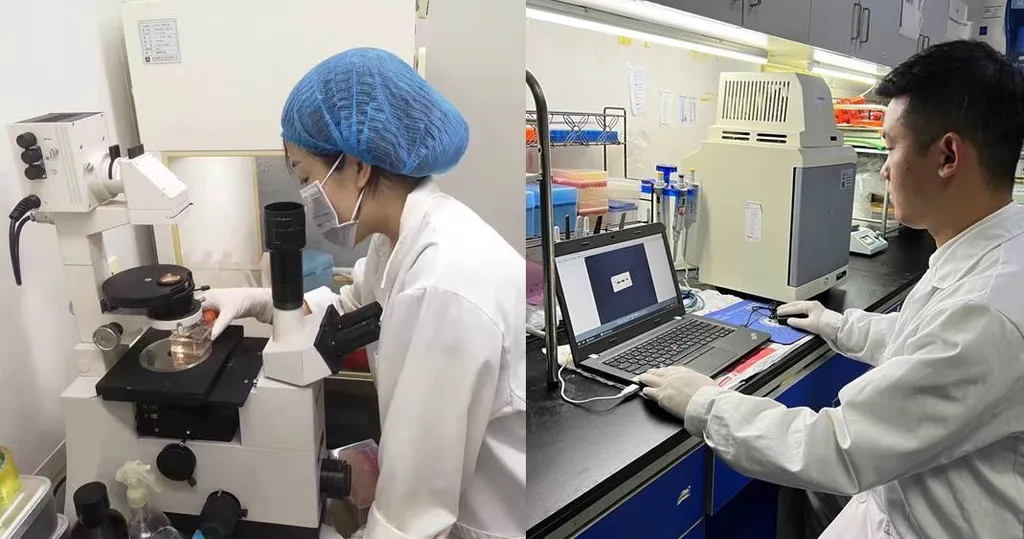In the intricate dance of insect metamorphosis, a tiny molecular switch has been discovered that could have significant implications for pest management and our understanding of hormonal regulation. Researchers, led by Qianyu He from the College of Life Science and Biotechnology at Heilongjiang Bayi Agricultural University in China, have uncovered how a process called SUMOylation acts as a molecular switch for the transcription factor Krüppel homolog 1 (Kr-h1), governing its dual roles in regulating the Broad-Complex (Br-C) gene. This finding, published in the Journal of Advanced Research (translated as “Journal of Advanced Research”), sheds light on the crosstalk between juvenile hormone (JH) and 20-hydroxyecdysone (20E), two key hormones driving insect development.
Kr-h1 is a crucial player in the antagonistic actions of JH and 20E, acting as a mediator for JH’s effects. Previous studies have shown that Kr-h1 can both repress and activate Br-C, a gene central to the 20E signaling pathway, depending on the developmental stage. However, the mechanism behind this dual functionality has remained a mystery until now.
He and her team found that Kr-h1 undergoes stage-specific SUMOylation, a post-translational modification that attaches Small Ubiquitin-like Modifier (SUMO) proteins to target proteins, altering their function. “We discovered that Kr-h1 is highly SUMOylated in early third-instar larvae,” He explains. “This modification allows Kr-h1 to interact with the histone methyltransferase SmydA-8, repressing Br-C expression.” As the insect progresses to the white prepupal stage, Kr-h1 is deSUMOylated, disrupting its interaction with SmydA-8 and thereby activating Br-C expression.
The researchers identified lysine 113 (K113) as the primary SUMOylation site in Kr-h1. They also found that JH stimulates Kr-h1 SUMOylation by enhancing its interaction with the SUMO-conjugating enzyme Ubc9, while 20E promotes deSUMOylation through increased association with the deSUMOylating enzyme ubiquitin-like protease 1 (Ulp1). Co-stimulation with both hormones synergistically amplified deSUMOylation, highlighting the intricate balance between JH and 20E signaling.
This study establishes SUMOylation as a critical regulator of Kr-h1’s stage-specific activity, providing a mechanistic framework for understanding how post-translational modifications confer functional plasticity to transcription factors during pivotal developmental transitions. “Our findings reveal how SUMOylation orchestrates the crosstalk between JH and 20E signaling,” He says. “This molecular switch mechanism could be a key target for developing novel insect growth regulators.”
The implications of this research extend beyond basic science. Understanding the molecular mechanisms governing insect development can lead to the development of more effective and targeted pest management strategies. By targeting the SUMOylation pathway, researchers may be able to disrupt the delicate balance of hormonal regulation in pests, potentially leading to new methods of control.
Moreover, this study highlights the importance of post-translational modifications in regulating gene expression and developmental processes. As He notes, “This work opens new avenues for exploring the role of SUMOylation in other developmental contexts and organisms.” The findings could have broader applications in agriculture, contributing to the development of sustainable pest management practices that minimize environmental impact.
In the ever-evolving field of agritech, this research represents a significant step forward in our understanding of insect physiology and the molecular mechanisms driving development. By unraveling the complexities of hormonal crosstalk, scientists are paving the way for innovative solutions to longstanding challenges in pest management. As the global demand for sustainable agriculture grows, insights like these will be crucial in shaping the future of the industry.

